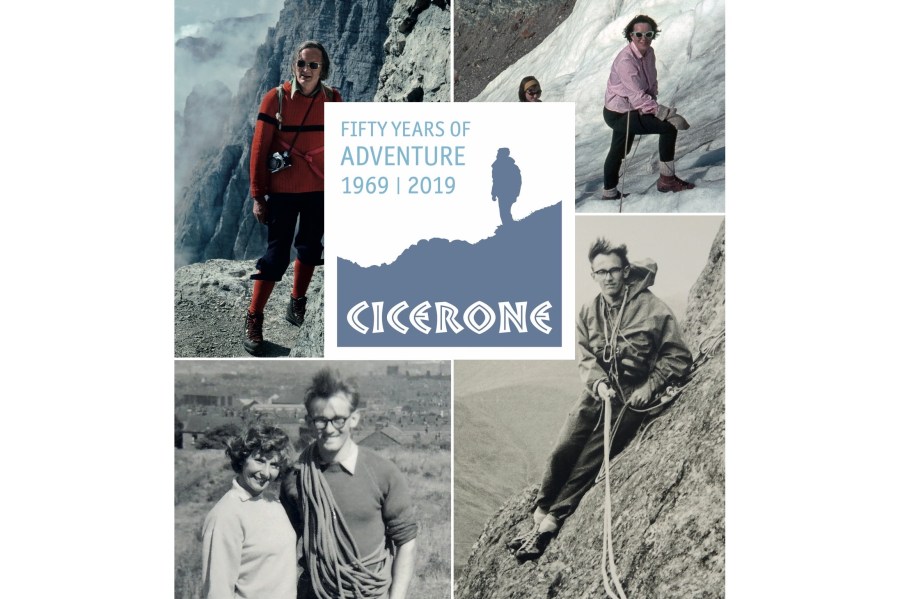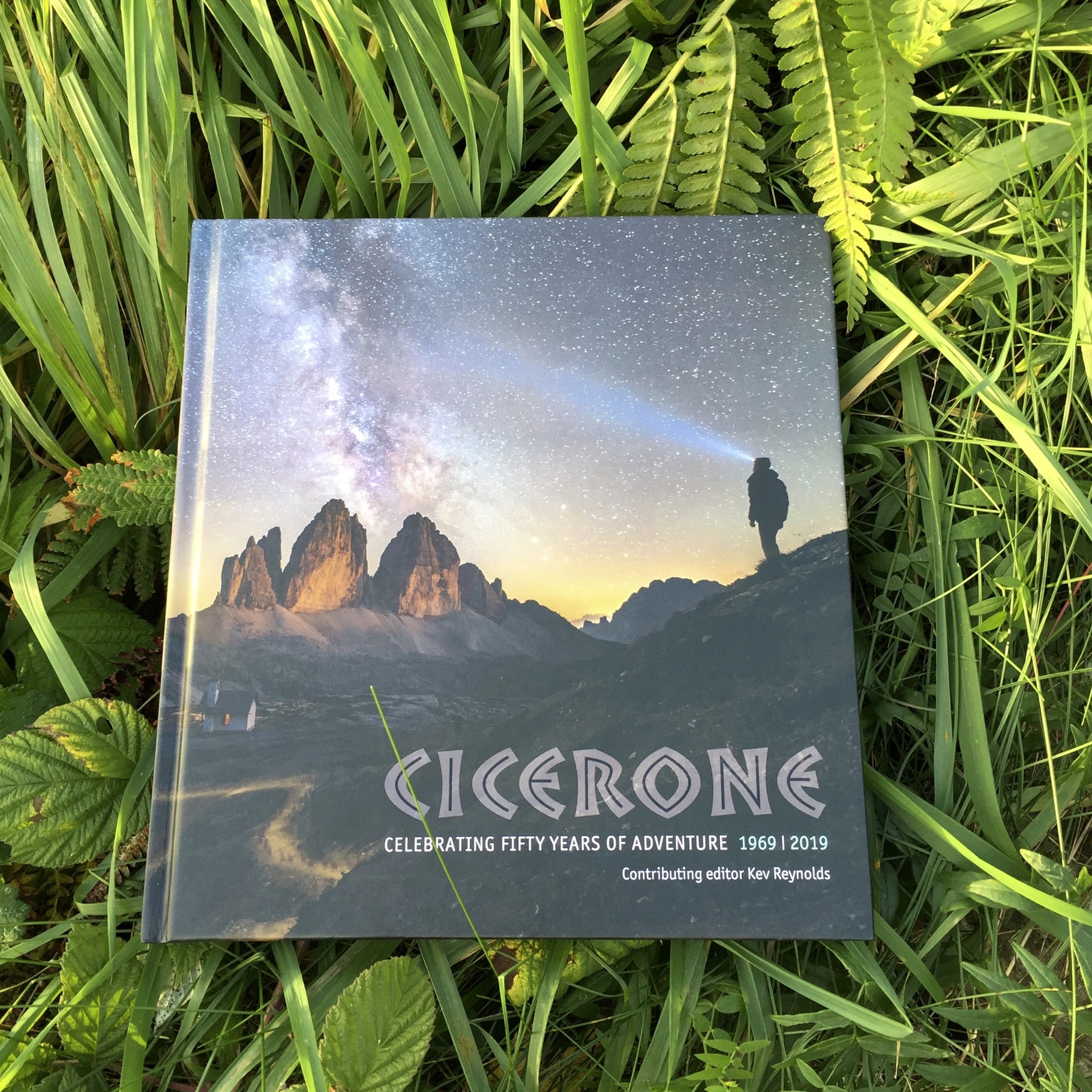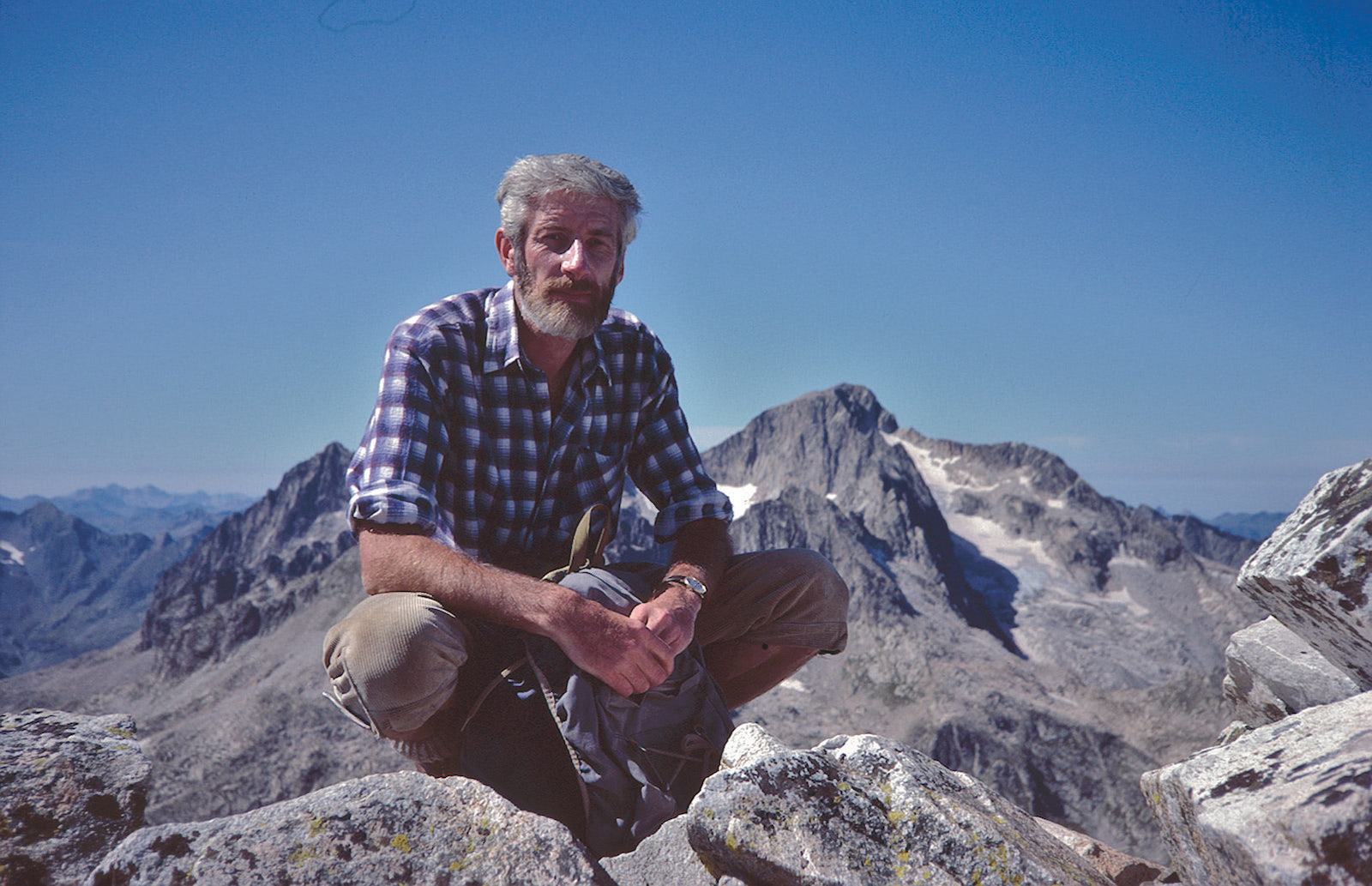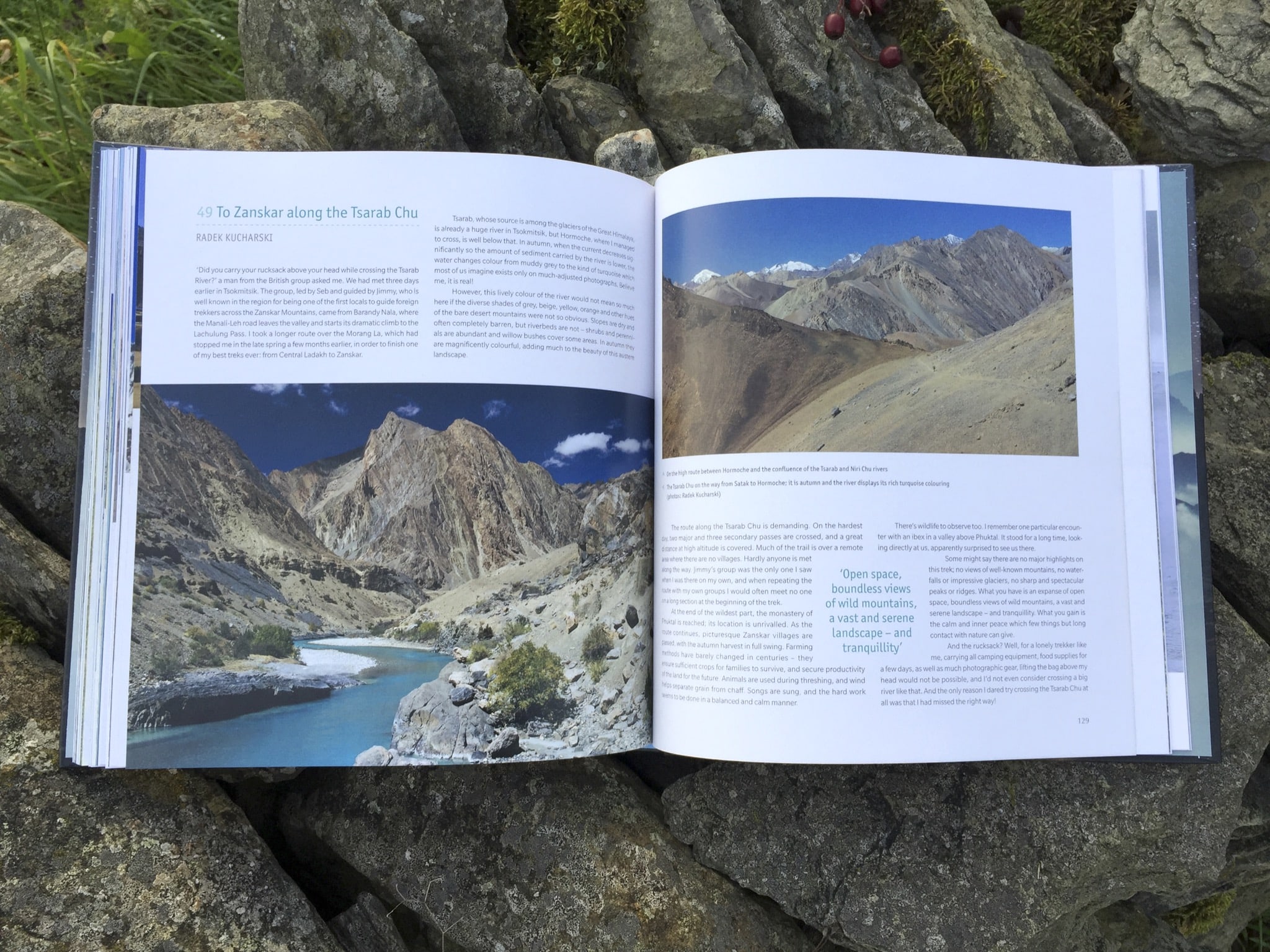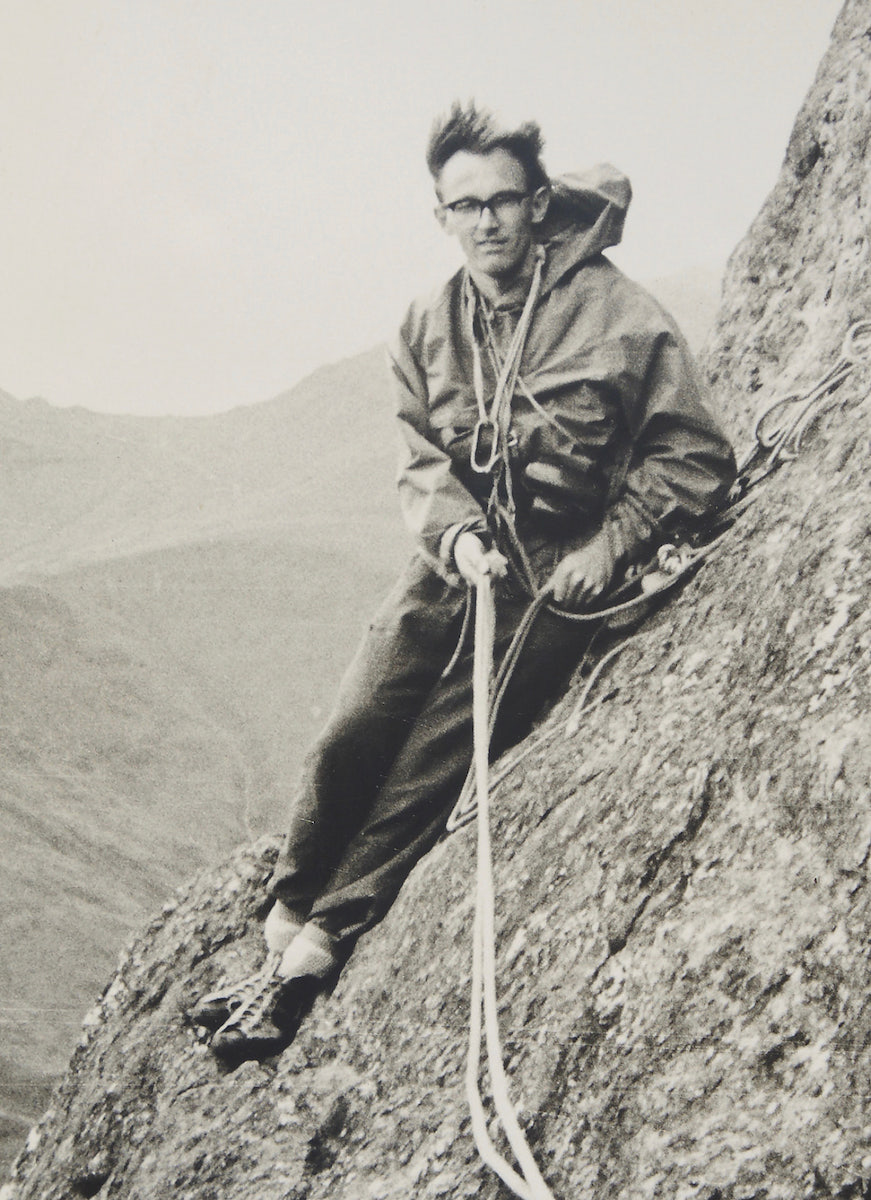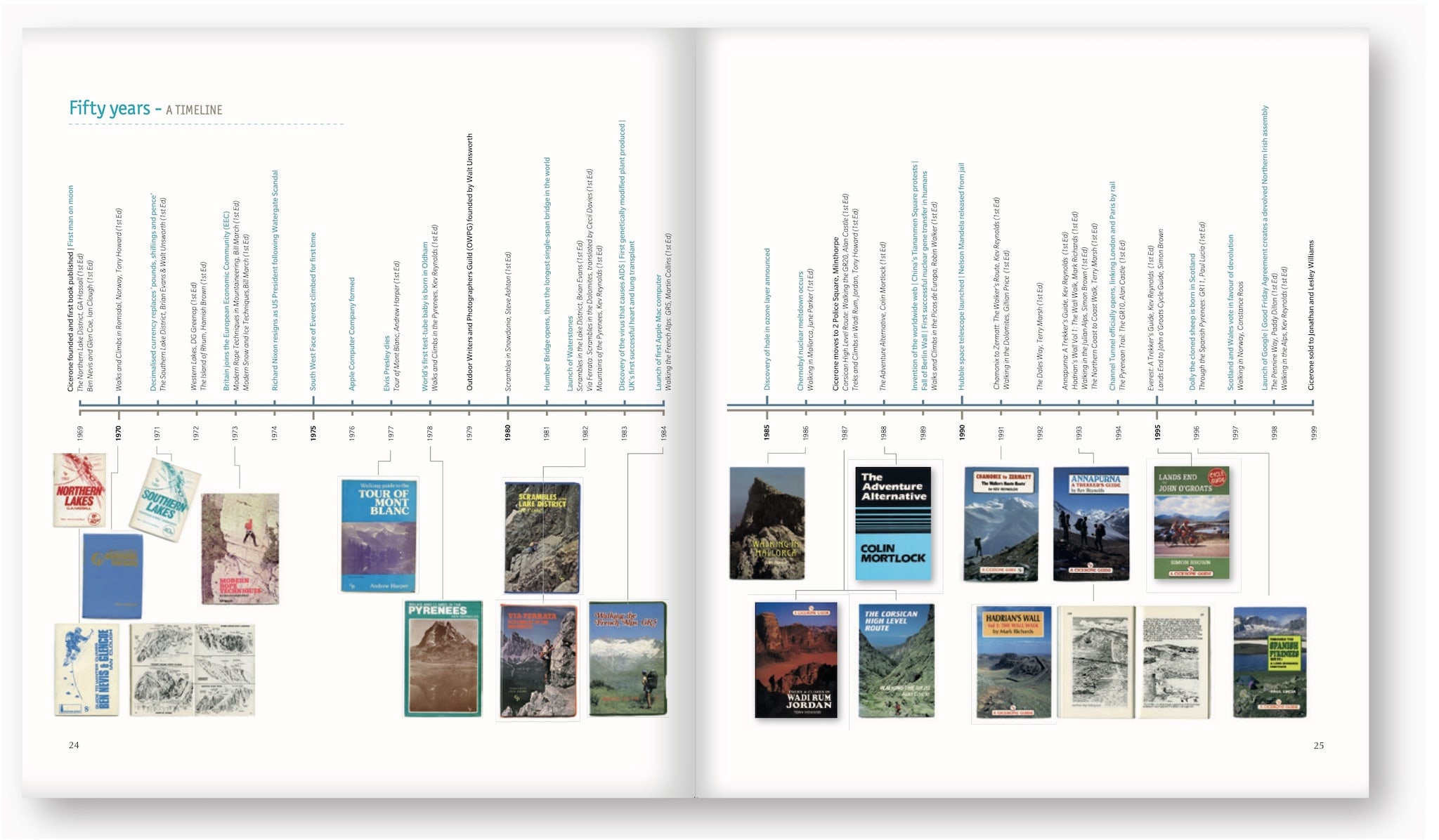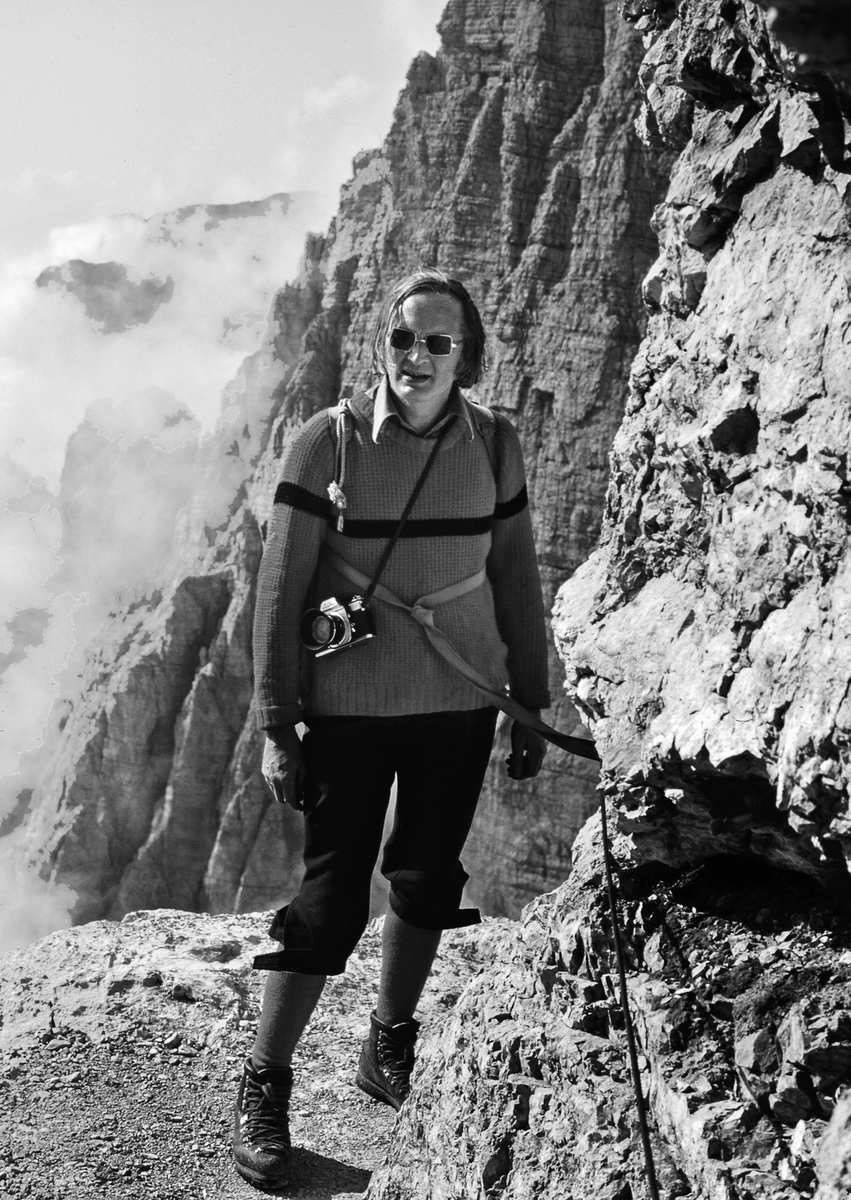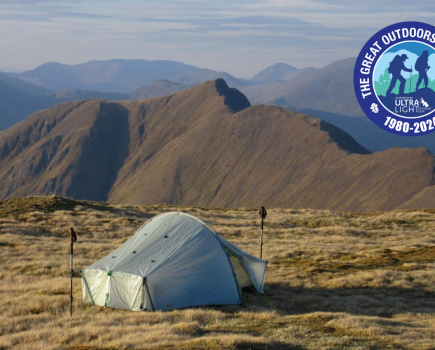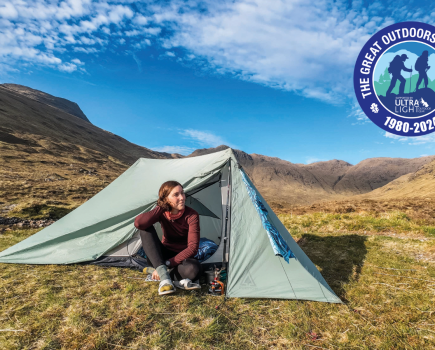“Embrace the challenge of the unknown… for in that lies some of the romance, the appeal, and the very essence of adventure.”
Commemorating Cicerone’s 50th year, Fifty Years of Adventure is a compilation of tales by Cicerone authors. A story to celebrate each year Cicerone has been publishing outdoor activity guidebooks, the collection is a delicious hotpot of adventures in their every shape and form.
Accompanied by outstanding photography, each page of this finely crafted anniversary book is a veritable visual delight. As enchanting as it is inspiring, Fifty Years of Adventure is a must for anyone with an appreciation for adventure.
To learn more about the making of this remarkable book, The Great Outdoors got in touch with Kev Reynolds (contributing editor and author) and Jonathan Williams (Cicerone’s publisher and managing director). This in-depth interview offers fascinating insights into the process of making guidebooks, some of the dangers authors face while investigating new routes, the meaning of adventure, and the changing face of publishing.
Alex Roddie: Please introduce yourself. Who are you and what do you do? What’s the story of your involvement with Cicerone Press?
Kev Reynolds: “I’m Kev Reynolds, and as a freelance travel writer and lecturer specialising in mountains and the countryside, I claim to be the man with the world’s best job. Being paid to do what I’d otherwise be doing on holiday has a lot going for it. Having spent the best years of my working life among some of the most dramatic landscapes on the planet has been uplifting and more rewarding than I deserve. But I haven’t had a holiday in decades…
“My involvement with Cicerone Press dates back to 1976. In those days I ran a youth hostel in Kent with my wife. It was a challenging job, the wages were pitiful, but we met thousands of like-minded outdoor folk with whom we could share our love of the countryside. In order to pay for holidays in the mountains I’d write articles for magazines and newspapers when everyone had gone to bed, and my wife would type them for me when she could find the time between all her other duties.
“One day I received a call from Walt Unsworth. Noted mountain historian, editor and co-founder of Cicerone Press, he said he’d read some of my pieces about the Pyrenees, and asked if I would write a guide to those mountains for him. Until then I’d never even looked at a guidebook, let alone used one, but Walt polished my ego so I said yes. As a result, Walks and Climbs in the Pyrenees was published in 1978, and forty years on, it’s still in print.
“Madeline Williams’s story of trekking on horseback through the Tian Shan mountains of Kyrgyzstan gave me an unsettling urge to go there myself”
“That little book sparked commissions from other publishers, so when YHA changed in the 1980s and we found ourselves out of step with the new management, we left youth hostel work and I became what the comedy writer Frank Muir called self-unemployed. With Walt Unsworth’s encouragement, and my wife’s unflinching support, I found myself producing two and sometimes three books a year for Cicerone and a clutch of other publishers. Although never a ‘staff member’ I’ve been part of the Cicerone family ever since, for when Walt and his partner Brian Evans retired in 1999, their successors Jonathan and Lesley Williams became every bit as generous to me with their encouragement and friendship.
“There are plenty of other writers with far more talent who’ve not had the breaks that I have, so when Jonathan asked me to take on the role of contributing editor for a special book to celebrate Cicerone’s fiftieth anniversary, I accepted before he could change his mind.”
Jonathan Williams: “I’m Jonathan Williams, the MD of Cicerone since 1999 and co-owner with Lesley Williams, who is Cicerone’s Marketing Director during this period. The story of how we came to be involved with Cicerone is in the Fifty book. Over the 20-year period my main role has been on the publishing side (although it has included almost everything that needed to be done; I once spent a year as the cleaner). Now that Cicerone has grown we have people or teams in all areas from commissioning, editorial, production, design as well as sales, marketing and even finance, so I am getting to do more leading the team, and even a bit more walking and exploring.”
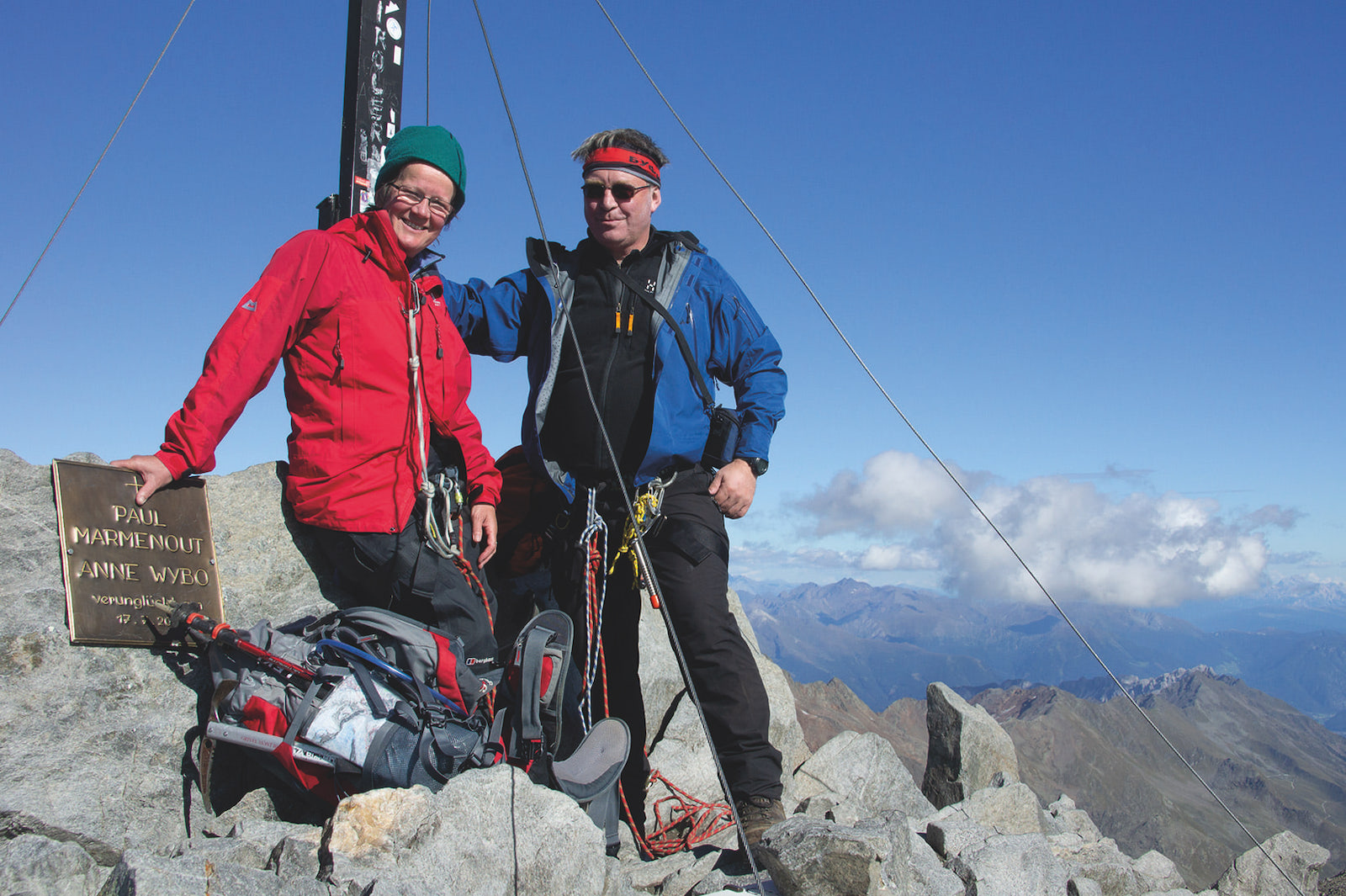
Lesley and Jonathan Williams on the summit of the Wilder Freiger in Austria’s Stubai Alps (photo: Joe Williams)
AR: There’s a huge variety of stories in Fifty Years of Adventure from many different Cicerone authors. Do you have any favourite stories – and any that particularly surprised you?
KR: “Because there’s such a variety, it’s almost impossible to have a favourite. Each of the authors told their story of an experience or a particular place with enthusiasm that I found truly engaging, and their arrival in my ‘in-tray’ gave a boost to the start of each day. Some had me laughing out loud. Some were moving accounts of an unexpected adventure; a few stories were expressed in such beauty of language that I would read them over and over again just to enjoy the words.
“Madeline Williams’s story of trekking on horseback through the Tian Shan mountains of Kyrgyzstan gave me an unsettling urge to go there myself, while Tony Howard’s description of the Jordan Trail – illustrated with the most extraordinary photos – bears more than a flavour of the exotic, as does Hamish Brown’s tale of his journey to Bou Guemez in Morocco’s Atlas Mountains.
“The aim is to lead my readers away from the familiar into places that will reward with the surprise of the new, for it’s only by venturing into the unknown that they will find their own adventures – but not at the risk of life and limb”
“Old Cicerone hands like Paddy Dillon, Ronald Turnbull, Terry Marsh and Gillian Price (to name but a few) lived up to their reputations by providing exactly what was needed in their own inimitable styles – they are true professionals and a privilege to work with. But what was especially rewarding for me as commissioning editor was the response I received from everyone invited to contribute stories. It proved to be a real ‘community project’ that underlined the widespread respect that Cicerone has earned from its authors and users over half a century of gently guided adventures.”
JW: “Think Kev has fully answered, but really I loved them all, showing the full range of adventure we cover. Adventure is a very personal thing, different for every person, and that is one of the reasons why we love being an enabler of others’ adventures – the ‘great time on the hill’.”
AR: In the book, Cicerone’s mission is described as to ‘provide a great time on the hill’. Given that a successful adventure is often a delicate balance between having the right information and retaining an element of risk or uncertainty, how does Cicerone try to find the right equilibrium?
KR: “I can only answer that question by my own experience, although I suspect this response would be echoed by most of my fellow guidebook authors.
“As a young father I introduced my two daughters to the mountains and countryside before they could even walk. And as they grew and became more independently active, they learned that the outdoor world was full of surprises, full of beauty and wonder – every day was an adventure, because they were in a different environment facing different challenges from the ‘safe and familiar’ at home.
“I would nurture that sense of adventure (and wonder) by retaining uncertainty but limiting the degree of risk involved – without eliminating it entirely. They grew with each adventure and learned to anticipate dangers.
“Now adapt that attitude to writing guidebooks… Like a caring parent, the aim is to lead my readers away from the familiar into places that will reward with the surprise of the new (‘a great time on the hill’), for it’s only by venturing into the unknown that they will find their own adventures – but not at the risk of life and limb. When researching routes, it is I and my fellow guidebook writers who face unknown risk and uncertainty – getting lost and testing the boundaries so our readers won’t have to.
“Adventures ought not be dangerous to have value, but it’s the uncertainty of outcome that adds spice – be it on the Thames Path or climbing K2”
“Two illustrations: the first was when researching a route to a mountain hut in the Alps. Word had it that there was an easy glacier crossing, well-marked by the hut guardian, that avoided any major crevassed areas. A friend and I set out to try it, but the moment we stepped onto the ice I knew instinctively it was not safe. Nevertheless we continued for ten minutes or so before we had to make a hasty retreat. Moments later the central part of the glacier, which we’d just left, collapsed in on itself. Had we not turned back when we did, we’d have been swallowed by it. Needless to say, that hut approach never made it into the guidebook.
“On another occasion I hoped to work out an alternative to the Europaweg on the Chamonix to Zermatt Haute Route, but was bombarded by rockfall when climbing a series of ladders above a glacier on what would otherwise have been an exciting option. My friend and I were lucky to survive, but again, that was a route that never made it into print.
“Adventures ought not be dangerous to have value, but it’s the uncertainty of outcome that adds spice – be it on the Thames Path or climbing K2. We want our children (and readers) to grow and lead fulfilling lives. As I say in the Cicerone book: ‘Embrace the challenge of the unknown… for in that lies some of the romance, the appeal, and the very essence of adventure.’ An author’s role is to facilitate and encourage that sense of adventure in our books by giving just the right amount of information without taking away the readers’ responsibility to make his or her own judgements based on conditions at the time.”
JW: “Finding the right equilibrium is interesting, to be sure. We don’t pull back from things that are challenging, but we do take care to describe things as they are, in full detail where necessary, not hiding anything. Steadily improving photos and mapping certainly helps, as does the ability to put online resources together, especially for updates where there may be significant changes or issues.
“Kev and I have often reflected on early editions of books, how a guide to the Pyrenees might have suggested climbing the ridge, drop down 1200m, wade the river and climb the notch on the skyline 1500m higher before dropping 9km down the valley to a possible village. Clearly that wouldn’t really wash now, but a step-by-step guide to a wilderness trek is also quite wrong, infantilising even. Preserving the spirit of adventure is important, so keeping things tight and helping the trekker (in this case) at the critical points.
“Authors’ personal experience on the trails and in the mountains matters greatly. Their ability to judge a safe route and describe it the right way is a defining characteristic of a great author. Many will have had ‘interesting experiences’ – I certainly have, exploring new places and routes – and these experiences all come through in our work, perhaps in where not to go as well as where to go.”
AR: What changes have you seen taking place in the world of trekking and long-distance walking – and also the world of publishing?
KR: “The most obvious changes are due to the sheer volume of people tackling treks and long trails. When I first trekked to Everest in the early 1990s, two of us could walk all day and see few if any other Westerners, and we would often have the lodges to ourselves. But somewhere in the region of 50,000 visitors now pass through the Sagarmatha National Park entrance gate each year, and many of the lodges are fully booked!
“Likewise for many of the popular Alpine treks it’s now essential to reserve accommodation well in advance, while numerous lesser-known (but equally rewarding) multi-day routes remain little used. Some great new treks have been created in recent years; the challenge is to seduce walkers away from the bucket list routes.
“Trekking is still trekking. Putting one foot in front of the other, discovering what is around the next hill, safely journeying through the region, the hills and coming safely to the other side”
“There’s also a growing disconnect with the environment among many of today’s trekkers. It’s not unusual, for example, to see walkers on the trail concentrating on their handheld devices and wearing earphones listening to music – being distracted from the realities of the world through which they’ve chosen to walk, making them deaf to birdsong, the rush and roar of a mountain torrent, the wind rustling among leaves. These are all essential elements in the outdoor experience whose appreciation can be lost through misuse of technology. To my mind trekking in wild places should be a multi-dimensional adventure – as it used to be.
“As for changes in the world of publishing – where do I start? Production values have raced ahead of where they were when I began writing guidebooks. In the early days guides were illustrated with a handful of black-and-white photos and rough, hand-drawn maps. Today we have colour throughout, professional mapping and protective covers. In addition, major changes to route descriptions or accommodation details can be lodged on the publisher’s website to enable walkers to check for updates before they set out.
“We’ve gone from typewritten manuscripts to Kindle and e-book options, from local small-scale printing presses to the digital wizardry of the Far East. But the essentials remain the same as they were when Cicerone began – to enable our readers to enjoy a great time on the hill.”
JW: “Trekking is still trekking. Putting one foot in front of the other, discovering what is around the next hill, safely journeying through the region, the hills and coming safely to the other side.
“Before trekking I spent years sailing. We had a great word, ‘seamanship’ – perhaps a little old-fashioned sounding now – which conveyed the techniques, skills, mindset and courage necessary to take a small boat (or even a big boat) full of people across a sea. There isn’t an equivalent one-word for trekking. ‘Mountaincraft’ might be nearest but hasn’t stuck and tends to be more about climbing. I hope we have in our way contributed to a level of trekking and mountain competence that has facilitated safe independent adventures.
“Writing is a tough industry, a calling even”
“Changes in the world of publishing are almost too numerous to mention. Digital production, internet selling, struggles of physical retailers all spring to mind. Going back 20 years the changes have been vast; going back to Cicerone’s first work 50 years ago, enormous.
“But it’s also interesting to reflect on what doesn’t change, which is the mission Cicerone set off with to help walkers, trekkers, cyclists, mountaineers and climbers have adventures, to blend inspiring and informing so that users know they can go and how to get the best of things when they are on the route.”
AR: How do you see Cicerone evolving to meet possible changes ahead in the next few decades?
JW: “We constantly challenge ourselves to improve, to make better guides, better researched and presented, all the time. To add digital offerings around the guides, to provide extra inspiring information – look for example at Cicerone Extra on our website, an absolute mine of information and ideas on routes and regions to explore, much of it written by authors, the team here but also and especially by customers helping other customers explore and discover.”
AR: Any words of advice for would-be travel writers?
KR: “Learn what’s important in life, forget any ambition to become rich, get out there and soak in every experience, and follow your dream.”
JW: “Writing is a tough industry, a calling even. Be true to yourself, but (especially for guidebooks) be prepared to master the skills of researching, writing, cartography, photography that are the underpinning of the work. When this is in place you really will have the skills to inspire trekkers and walkers to have great adventures.
“And as Kev says, follow your dream.”
Fifty Years of Adventure is available to purchase now from Cicerone Press (£22.50)

